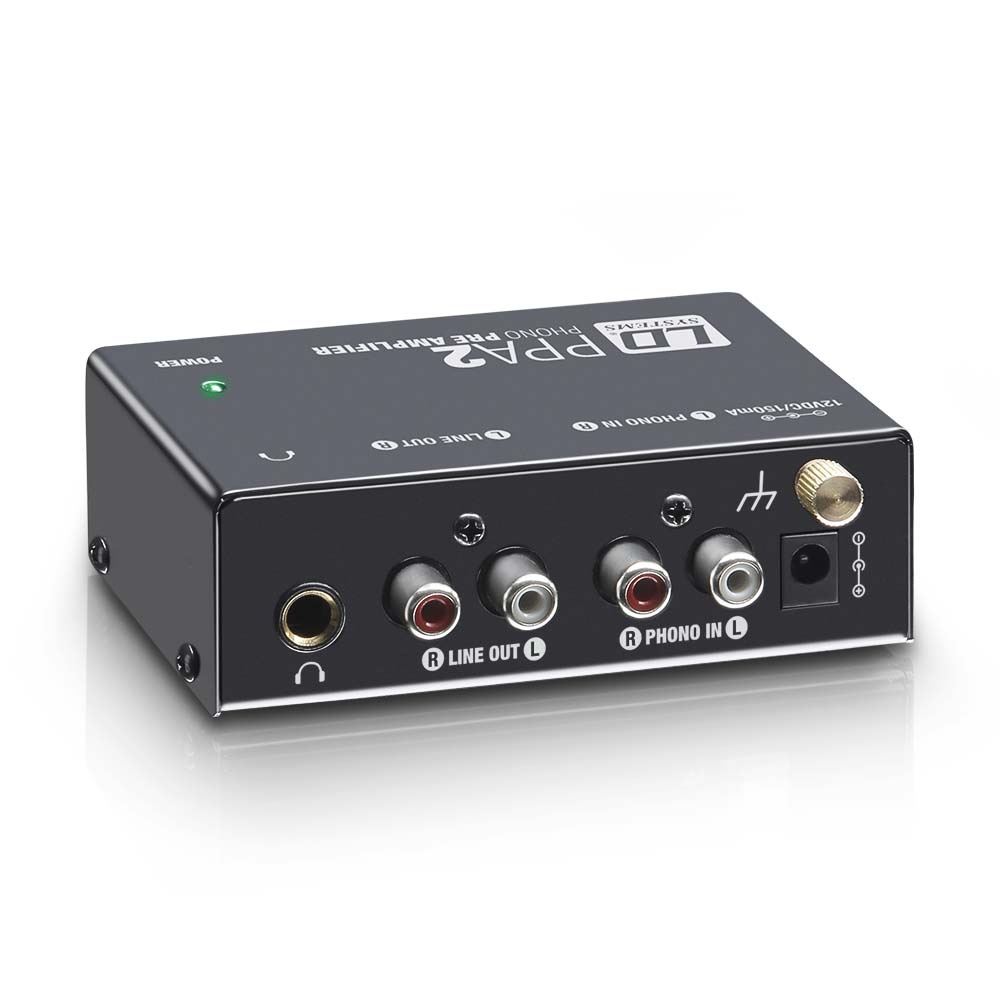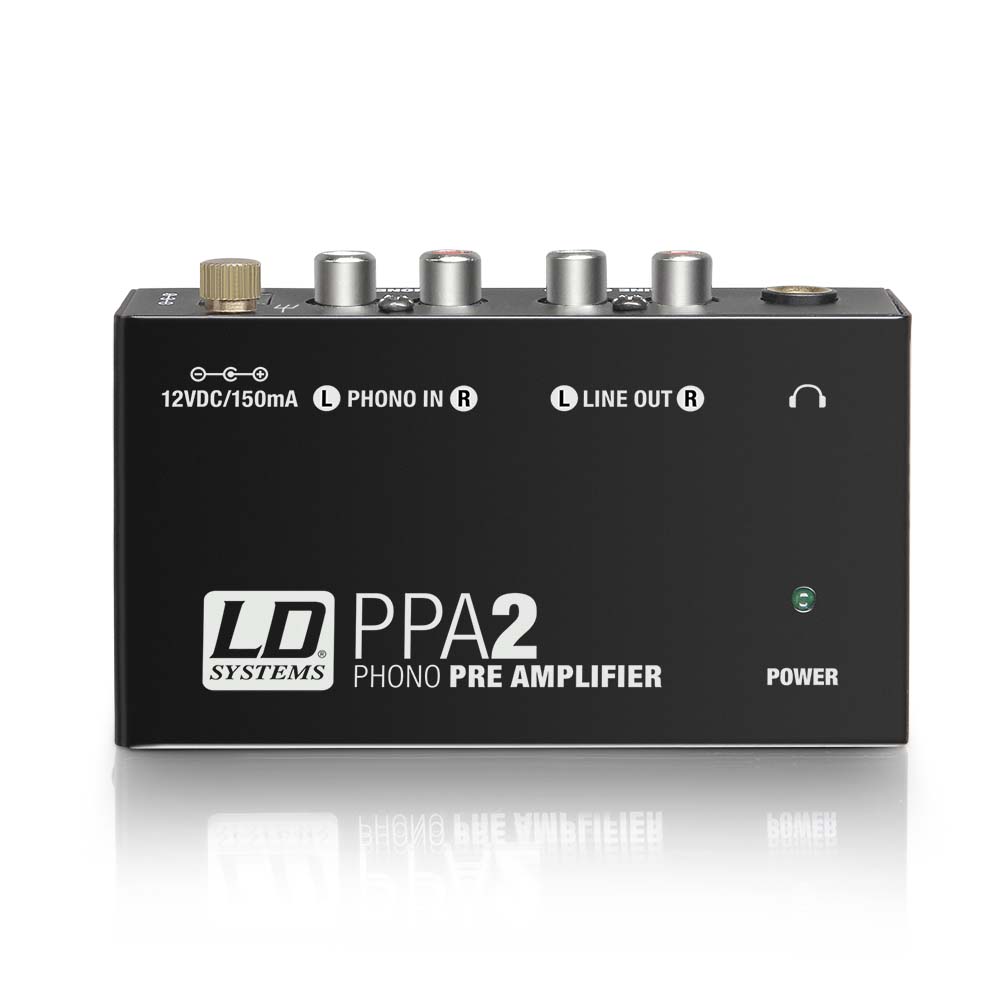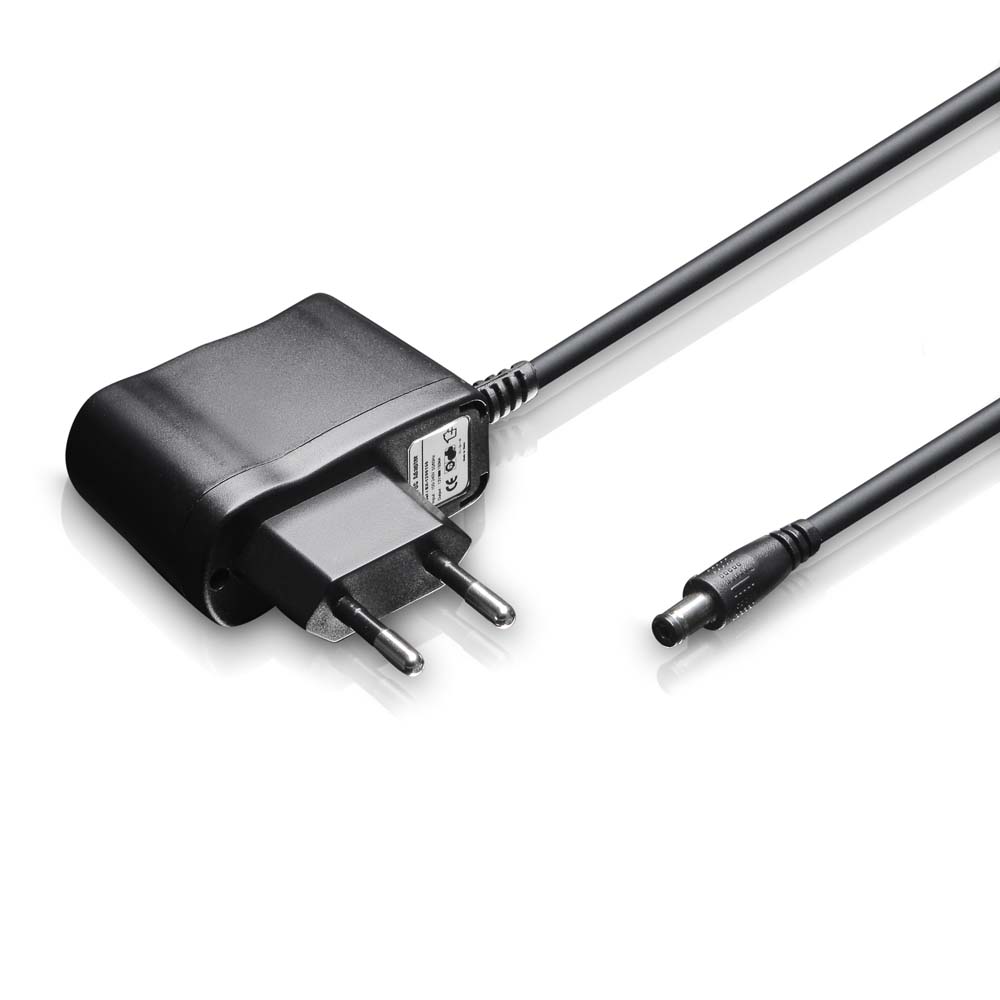| Content | User's manual
- Ultra compact phono preamplifier and equalizer
- Proper RIAA equalization
- RCA inputs and outputs
- 6.3 mm stereo headphone output connector
- Sturdy metal housing
- 12 V AC/DC adapter included
The LD Systems PPA 2 is a very compact analogue phono preamplifier, which equalises the extremely low output signal of conventional turntables to RIAA standards. It allows you to connect to devices without any phono input, such as mixers, PA power amplifiers or sound cards. The phono inputs are designed as RCA jacks, just like the line outputs; the PPA 2 also has a screw terminal for the ground conductor of the turntable and a 6.3 mm stereo jack for connecting a headset. The THD factor of the preamplifier is below 0.05% and the channel separation is -75 dB. The LD Systems PPA 2 uses a 12 V AC adapter; a bright LED indicates the power supply on the top of the sturdy metal chassis.
Product type
Other Studio and Recording Equipment
Type
Stereo Input / Stereo Output
Frequency response
RIAA Curve Hz
Signal-to-noise ratio
70 dB
THD |
EWI PDI-100 PARA ACOUSTIC DI Box
This is a medium grade professional application Para Acoustic Active DI, which will work well on instruments with passive pickups or active pickups.
The construction is reasonably rugged and the components are well suited for the application yielding results that are typically acceptable for all but the most discerning artists.
The on-board tone and volume controls give the operator a lot of choices in shaping their sound prior to sending the signal to the mix console. This allows an artist to use this device in-place of or in addition to a traditional stage amp for their instrument. This is an excellent choice for IEM bands, or bands that like to keep their stage volume low.
This item is typically used to split the instrument signal going to a stage amp so a feed can be sent also to the mix board, or be used as a stand-alone instrument pre-amp. It is equipped with a ¼” jack for input, a 1/4" jack for output to a stage amp, one XLR jack for the send to the board and a TRS jack for inserting an FX device.Since this is an active D.I. box, it needs to be powered which can be done either with Phantom Power from the mix board, or with the supplied internal 9v battery. The battery is fairly easy to change by removing one screw in the bottom of the case.
|
Having had great success with the PRE-73 preamp, we have received many requests for a version for the 500 eries rack format. We are therefore happy to present the PRE-573, expected to start shipping in late September.
The PRE-573 is a one width module that has the sound and the features that made the PRE-73 so successful and a few additional ones.
The circuit still uses the preamp and output section from the classic 1073-module, adapted to work in the api rack format. It has a total gain range from -15 to +80 dB. The 10 - 70 dB range is handled by a turn switch and there is a separate toggle switch to select an additional 5 or 10 dB gain. The input can be configured to accept line level signals by another switch, the gain is then lowered by about 25 dB and the input impedance increased to about 15 kohm.
The input impedance of the mic input mode can be switched between 1200 and 300 ohm. Phantom power and phase reverse is also selectable by front panel switches.
An added feature, using the same circuit as in the PRE-73 DLX, is the active DI-input with a high input impedance of about 1,5 Mohm. The output signal from the active DI circuit passes through the input transformer for some extra character.
The DI-input is very flexible since it can be changed to a purely passive one by a front panel switch. The DI input is then exactly the same as in the PRE-73 Mk2 where the signal is feed directly into the second gain stage, bypassing the transformer and with an input impedance of about 100 kohm.
These two DI-options makes it possible to get different tones from electric instruments and the passive DI input mode is more suited for injecting active units like sound modules.
A new feature is the switchable AIR mode that adds a small boost above 10 kHz that peaks at 2 dB at about 35 kHz.
A simple but effective signal and overload indicator is offered by a single LED that starts glowing red at about +4 dBu and then increases its intensity up to the maximum output level.
The PRE-573 has a dedicated insert connector at the back allowing it to interface with other GAP 500 modules. The insert can be activated by removing a jumper connector at the back of the module.
The second Golden Age Project module for the api 500 rack will be the EQ-573, expected to ship in November 2012. The EQ-573 consists of the inductor based high pass filter section and the 3-band eq section from the classic 1073 module with some added frequencies. These two modules together will offer a fully fledged 1073-module in a compact format at a very low cost.
There is a second jumper at the back of the module that selects 600 ohm termination on the output. The standard mode is termination on, since it gives the flattest response when the PRE-573 is used with modern line inputs that typically has an input impedance of 10 kohm or more. The user can chose to remove the jumper and deactivate the termination resistor, this will increase the level above 10 kHz and create a peak in the response for an even more pronounced "Air" effect.
The output is transformer balanced and fully floating and can drive a 600 ohm load up to level of about 28 dBu.
| ISA OneClassic Single-channel Microphone Pre-amplifier with Independent D.I.
Key Features
ISA Series Transformer-based Pre-amplifier
Encased in a rugged and portable chassis, ISA One offers the classic Focusrite microphone pre-amplifier at its lowest cost to date.
Flexible Independent D.I. Channel
ISA One is ideal for both engineers and demanding performers alike, featuring independent gain control, an output for routing to an amp, an independent XLR output on the rear and routing to the optional ADC.
Switchable Impedance
Choose one of four carefully selected input impedances, including the original ISA 110 setting, to suit any microphone.
Optional Stereo 192kHz ADC
This optional card embodies cutting-edge conversion technology, incorporating Focusrite analogue circuitry to deliver the best A-D performance in its class (Dynamic range of 119dB).
Rugged Custom Flight Case
Built to protect your ISA One from the rigors of the road. Rugged plywood construction with a solid polypropylene exterior and reinforced corners.
Headphone Output with Volume Control
ISA One can feed either a sum of the two inputs to the headphones output, or an external stereo cue mix (such as a stereo mix feed from an interface) via two TRS Jack inputs on the rear of the unit.
Dedicated Insert Point
Allows you to place extra processing between the pre-amplifi er or D.I. and the optional converter, such as an EQ or compressor.
Specifications
Analogue Channel Inputs
- XLR Mic input
- One XLR and one TRS line input
- XLR Instrument input TRS Jack
- External ADC input TRS Jack
- TRS jack return
|
Analogue Channel Outputs
- TRS jack send
- XLR balanced line output
- XLR DI output
- TS jack DI through
|
Analogue Channel Additional I/O
- TRS Jack cue mix left input
- TRS Jack cue mix right input
- 1/4” TRS Jack headphones output
|
Mic Input Response
| Gain range |
0dB to 60dB in 10dB steps + 20 dB of variable gain |
| Input Impedance |
Switched Impedance setting Equivalent Input Impedance at 1kHz |
Low = 600 Ohms
ISA110 = 1400 Ohms
Med = 2400 Ohms
High = 6800 Ohms |
| EIN (Equivalent Input Noise) |
-126dB measured at 60dB of gain with 150 Ohm terminating impedance and 22Hz/22kHz band-pass filter |
| Noise |
Noise at output with unity gain (0 dB) and 22 Hz-22 kHz band pass filter |
-97 dBu |
| Signal-to-Noise Ratio |
106 dB relative to max headroom (9dBu) |
| Total Harmonic Distortion + Noise |
Measured at medium gain (30dB) with a 1kHz -20dBu input signal and with a 22Hz/22kHz band-pass filter |
|
| Frequency Response |
At minimum gain (0 dB) |
-0.5dB down at 10Hz and -3dB down at 125kHz |
|
At maximum gain (60dB) |
-3dB down at 16Hz and -3dB down 118kHz |
| CMRR (Common Mode Rejection Ratio) |
98dB (Channel 1, 1kHz, maximum gain with +24 dBu input) |
| Crosstalk Channel to Channel |
With 10dB@1kHz input to chA, chB output =104dBrA. With 10dB@10kHz input to chA, chB output = 84dBrA |
Line Input Response
| Gain range |
-20dB to +10dB in 10dB steps + 20 dB of variable gain |
| Input Impedance |
10 kΩ from 10 Hz to 200 kHz |
| Noise |
Noise at main output with gain at unity (0 dB) measured with 50 Ω source impedance and a 22Hz - 22 kHz band pass filter |
-96 dBu |
| Signal-to-Noise Ratio |
Measured with a 22 Hz-22 kHz band pass filter |
120 dB relative to max headroom (24 dBu)
118dB relative to 0dBFS (+22dBu) |
| Total Harmonic Distortion + Noise |
Measured with a 0 dBu input signal, and a 22 Hz-22 kHz band pass filter |
0.0001% |
| Frequency Response |
At unity gain (0 dB) |
-0.3dB down at 10Hz and -3dB down at 200kHz |
Instrument Input Response
| Gain range |
10dB to 40dB continuously variable |
| Input Impedance |
High = greater than 1M
Low =greater than 300k |
| Noise |
Measured with 22 Hz-22 kHz band pass filter |
Minimum gain (+10 dB): -92 dBu
Maximum gain (+40dB): -62dBu |
| THD |
At minimum gain (+10) |
| Frequency Response |
At minimum gain (+10 dB) |
-10dB input: 10Hz-100kHz +/- 0.6dB |
|
At maximum gain (+40 dB) |
-40dB input: -2.5dB down at 10Hz and 0dB at 100kHz |
Meters
| Moving Coil (MC) Meter |
factory calibrated to 0VU = +4dBu with 1kHz sinewave. With the VU Cal button pressed the meter can be adjusted on the rear panel to allow 0VU to equal +10dBu to +26dBu with the centre detent being equal to +22dBu. |
| Peak LED Meters |
Calibrated in the detent position for 0dBFS = +22dBu, calibration is adjustable on the rear panel to allow 0dBFS to equal +10dBu to +26dBu |
| Routing for MC and Peak1 meter is after the HPF, pre insert send or switched post insert return. Peak2 is always pre ADC channel 2, which can be fed by external input or Instrument input. |
| LED Levels |
As follows, when peak calibration is set to center detent on the rear panel. (This is when using the internal ADC). |
0 = +22dBu
-2 = +20dBu
-6 = +16dBu
-12 = +10dBu
-18 = +4dBu
-42 = -20dBu |
| Frequency Response |
At minimum gain (+10 dB) |
-10dB input: 10Hz-100kHz +/- 0.6dB |
|
At maximum gain (+40 dB) |
-40dB input: -2.5dB down at 10Hz and 0dB at 100kHz |
High-Pass Filter
| Roll-Off |
18 dB per octave (3 pole filter) |
| Frequency |
Fixed 75Hz measured at the 3dB down point |
Weight and Dimensions
| W x D x H |
220mm (W) x 104mm (H) x 254 - 290mm (D - top to bottom) |
8.66" (W) x 4.1" (H) x 10" - 11.4" (D - top to bottom) |
| Weight |
3.9 kg |
8.6 lbs |
|
At PreSonus, weʼve been designing preamps for a long time, and we always focus on audio quality first. So when we decided to upgrade our popular TubePre V2, we focused on improving an already high-quality sound—without jacking up the price. Like the originalTubePre, the new version is a fully professional tube preamp, with a dual-servo (no capacitors) gain stage that lets you boost the program signal to smoking hot levels without significantly increasing the background noise. Discrete components and high-voltage operation offer dynamic range and detail not found in other single-channel tube preamps in its class.
Housed in a rugged case, the TubePre V2 rear panel sports separate unbalanced, ¼” instrument and balanced, XLR mic inputs and unbalanced ¼” and balanced XLR line outputs. Weʼve included all of the extras you need for professional operation including a high-pass filter, phantom power for condenser mics, polarity reverse switch, and a backlit VU meter.
|
The OctaMic II provides 8-Channel 192 kHz / 24 bit AD conversion with eight hi-class microphone and line pre-amplification channels, featuring a combination of sophisticated components and approved RME technology.
Lowest distortion, excellent signal to noise ratio and perfectly linear frequency response transmit and amplify the microphone signals truly unchanged.
The OctaMic II includes some significant enhancements compared to the OctaMic:
The balanced TRS inputs of the Neutrik Combo XLR jacks are phantom power-free and can be operated as real line inputs too. The improved design of the input circuits allows for a maximum input level of +21 dBu with a convenient gain range from 6 dB up to 60 dB.
Improved signal to noise ratio (SNR) ADC 107.5 dB
Improved THD, especially at higher gains
Optimised heat dissipation by a new and larger housing with improved convection
Internal wide range power supply with line filter, insensitive to voltage fluctuations
Super-stable, short circuit proof 48 V phantom power
Features
OctaMic II offers 8 balanced XLR mic / line inputs via Neutrik XLR/TRS combo jacks. Each channel contains switches for 48V phantom power, a low cut filter and phase reversal. Amplification can be set between 6 and 60 dB. LEDs for signal, clip, and activated phantom power give a complete overview on the unit's status. When the special Clip Hold mode is activated, any detected clip-state will cause the corresponding LED to flash once per second. With this, the user gets a long-term peak detection, and no longer needs to constantly watch the LEDs. At the same time momentary overloads are still displayed correctly.
Frontside switches include power on/off and output level, for a choice of -10 dBV, +4 dBu or Hi Gain (+19 dBu) as reference level. This unusual feature offers two advantages. First, the reference level can be easily switched to match any of RME's current interface devices, from HDSP 9632 through Multiface up to the renowned ADI-8 series converters. Second, the Signal to Noise ratio is optimized, and the Clip-LED will exactly match the ones of the ADI-8 (2 dB below 0 dBFS).
The balanced line level output signal is available at the back of the unit via 8 stereo TRS jacks. The specially developed, internal hi-performance switch mode power supply lets the OctaMic II operate in the range of 100V to 240V AC. It is short-circuit-proof, has an integrated line-filter, is fully regulated against voltage fluctuations, and suppresses mains interference.
Top
AD-Conversion
The 8-Channel AD-conversion of the OctaMic II operates at up to 192 kHz. The digitized signal is available simultaneously at the double ADAT output (S/MUX, up to 96 kHz), and at a DB-25 connector (4 AES/EBU outputs, up to 192 kHz). The digital part can be clocked internally (master) and externally via word clock, AES/EBU and SPDIF.
RME's outstanding SteadyClock(TM) ensures perfect AD-conversion, as jitter on the external sync-sources is nearly completely removed. All settings are done via DIP-switches on the back of the OctaMic II. Analog outputs and both digital outputs operate fully simultaneously. The choice of reference level affects the analog outputs only, the signal/clip indication and the AD-conversion will react only to the Gain-pots.
Top
Tech Specs
8 balanced XLR/TRS mic/line inputs
54 dB gain range
Input impedance: XLR 2 kOhm, TRS 5 kOhm
Analog input level: from -40 dBu up to +21 dBu
Maximum output level: +21 dBu
Output impedance: 75 Ohm
Output level switchable Hi Gain / +4 dBu / -10 dBV
Signal to noise ratio (SNR): 129 dB EIN @ 150 Ohm
THD:
Large frequency range (200 kHz) with special EMI input filtering
Frequency response -0.5 dB: 5 Hz - 200 kHz
Hi-pass filter: 80 Hz, 18 dB/oct.
Line Out: 1/4" TRS (6.3 mm stereo jack), servo-balanced
Phantom power: +48 Volt switchable per channel
Internal wide range switching power supply 100-240 Volt AC
Unbeatable price/performance ratio!
AD conversion
SNR: >110 dB(A)
Supported sample rates: 28 kHz - 200 kHz
THD:
Sync Sources: AES/EBU (also SPDIF coaxial), wordclock, internal
SteadyClock(TM) ensures best sound quality even with jittery external clocks
Top
Accessories
Digital breakout cable Pro, AES/EBU, D-sub25 to 4x XLR-3 female + 4x XLR-3 male, 1m/3m/6m (ALVA Audio)
Digital D-sub cable, AES/EBU, D-sub25 male to D-Sub25 male, 1m/3m/6m (ALVA Audio)
Optical ADAT Toslink cable 1m/2m/3m/5m/10m (ALVA Audio)
Word Clock cable, 1 x BNC male to 1 x BNC male, 1m/5m/10m (ALVA Audio)
Top
Add-On
BOB-32 Universal Breakout Box with 2 x 8 XLR to 2 D-sub connectors (supports TASCAM and YAMAHA format), flip-frame case
|




















Reviews
There are no reviews yet.